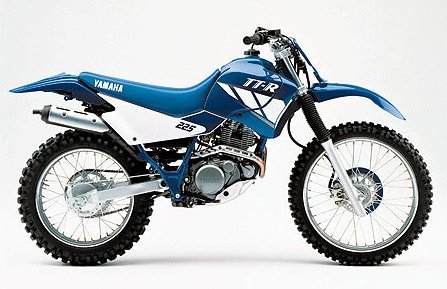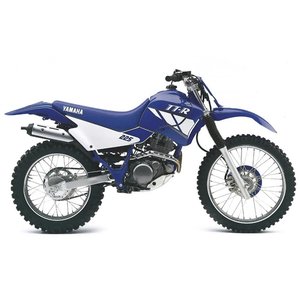Yamaha TT-R 225 (2000–2004): A Trail Companion Built for Confidence

Introduction
The Yamaha TT-R 225, produced from 2000 to 2004, remains a standout in the entry-level trail bike segment. Designed for riders seeking reliability, approachability, and a stress-free off-road experience, this air-cooled workhorse carved its niche as a gateway to adventure. After spending a day threading it through rocky trails, muddy paths, and open fire roads, it’s clear why this bike still resonates with beginners and casual riders. Its electric start, forgiving powerband, and bulletproof engineering make it less of a motorcycle and more of a trusted mentor for those learning the ropes of dirt riding. Let’s dive into what makes the TT-R 225 a timeless choice—and where it leaves room for aftermarket upgrades.
Design & Ergonomics: Approachable and Tough
Frame and Stance
The TT-R 225’s steel frame strikes a balance between durability and manageable weight. At 117.5 kg (259 lbs) dry, it’s light enough to maneuver through tight singletrack yet substantial enough to feel planted at speed. The seat height—870 mm (34.2 in)—is a sweet spot for riders between 165 cm (5’5”) and 180 cm (5’11”). Even at a standstill, the bike’s narrow midsection lets you dab a foot easily, a reassuring feature for newcomers.
Ground clearance sits at 290 mm (11.4 in), which handled most trail obstacles without scraping, though aggressive riders might crave an extra inch for gnarlier terrain. The telescopic forks (229 mm / 9.0 in travel) and link-type rear shock (193 mm / 7.6 in travel) are softly tuned, prioritizing comfort over precision—perfect for soaking up roots and rocks at moderate speeds.
Controls and Features
Yamaha kept things refreshingly simple here: no digital dash, no ride modes—just an analog speedometer and essential indicators. The wide handlebar offers leverage for steering, while the rubber-mounted pegs dampen vibrations. The inclusion of an electric starter (a rarity in this class at the time) is a game-changer. No more frantic kicking when stalled on a hillside!
Engine & Performance: Mellow but Dependable
Power Delivery
The 223 cc air-cooled single-cylinder engine pumps out a modest 20 HP at 8,000 RPM and 19 Nm (14 lb-ft) of torque at 7,000 RPM. Throttle response is linear, with no abrupt hits—ideal for building confidence. The 26mm Teikei carburetor (or 34mm Mikuni on later models) ensures smooth fueling, though it can feel hesitant at high altitudes without rejetting.
On open trails, the TT-R 225 tops out around 95 km/h (59 mph), but it’s happiest puttering between 40–70 km/h (25–43 mph). The six-speed gearbox is a highlight: first gear crawls up technical climbs, while sixth cruises fire roads without buzzing your hands numb.
Mod Potential
As noted in rider testimonials, the TT-R 225 responds well to basic tweaks. Removing the airbox snorkel and swapping the exhaust baffle for a freer-flowing unit adds a noticeable pep—though it’s still no racer. For those craving more, aftermarket camshafts and big-bore kits exist, but the engine’s real charm lies in its simplicity. Air cooling means no radiators to damage, and the SOHC 2-valve design is virtually indestructible with routine care.
On the Trail: Where the TT-R 225 Shines
Handling and Braking
The 21-inch front and 18-inch rear spoked wheels (shod with 80/100-21 and 100/100-18 tires, respectively) offer predictable grip on loose surfaces. Steering is neutral, requiring deliberate input rather than nervous corrections. At speed, the bike tracks straight through chop, though the soft suspension can wallow under hard braking.
The front 229 mm disc brake provides ample stopping power, while the rear drum brake… exists. It’s adequate for maintaining speed downhill but lacks bite—a common quirk of budget-friendly trail bikes.
Rider Experience
This is where the TT-R 225 truly earns its stripes. The low seat, gentle power curve, and light clutch pull make it forgiving for mistakes. During my test ride, the bike inspired confidence to tackle hill climbs and log crossings that would’ve intimidated me on a sharper machine. The suspension, while basic, never felt harsh—even after bottoming out on a misplaced jump.
Fuel economy hovers around 30 km/L (70 mpg), giving a 320 km (200 mi) range from the 10.2L (2.7 gal) tank. That’s enough for a full day of trail riding without hitting reserve.
Competition: How It Stacks Up
Honda CRF230F
The TT-R 225’s closest rival, the CRF230F, trades electric start for slightly sharper suspension and a peppier engine. Honda’s offering feels more agile at speed but demands kickstarting—a dealbreaker for some. Yamaha’s seat is also lower by 25 mm (1 inch), catering to shorter riders.
Kawasaki KLX230
A modern competitor, the KLX230, boasts fuel injection and adjustable suspension. However, its taller seat height (895 mm / 35.2 in) and higher price tag alienate budget-conscious beginners. The TT-R 225’s carburetor might be old-school, but it’s easier to repair trailside.
Suzuki DR200SE
Suzuki’s entry is lighter and cheaper but sacrifices low-end torque and suspension travel. The TT-R 225’s extra 23 cc and longer wheelbase make it more stable on uneven terrain.
Maintenance: Keeping Your TT-R 225 Alive
Key Considerations
- Air Cooling: No radiators to maintain, but ensure fins stay clean for optimal heat dissipation.
- Carburetor Care: Clean the jetting annually, especially if modding the airbox or exhaust. A clogged pilot jet is the usual culprit for cold-start woes.
- Chain & Sprockets: The O-ring chain lasts well, but adjust tension every 500 km (310 mi). Swap to a steel rear sprocket if the stock aluminum one wears out.
- Brake Upgrades: Consider a braided stainless steel front brake line for improved feel. The rear drum can be fitted with high-friction shoes for better stopping power.
Recommended Upgrades from MOTOPARTS.store
- High-Flow Air Filter: Unrestrict airflow without compromising dirt protection.
- Skid Plate: Protect the engine case from rock strikes.
- Handlebar Riser Kit: Improve ergonomics for taller riders.
- Aftermarket Exhaust: Shed weight and boost mid-range torque (while staying trail-legal).
Final Thoughts
The Yamaha TT-R 225 isn’t about breaking boundaries—it’s about breaking in new riders. Its approachable nature, rugged construction, and low-maintenance ethos make it a perfect first bike or a stress-free companion for casual trail adventures. While seasoned riders might outgrow its gentle demeanor, they’ll struggle to find a machine that so effortlessly blends forgiveness and fun.
Whether you’re reviving a barn find or optimizing a well-loved example, MOTOPARTS.store has the upgrades to tailor this classic to your needs. From skid plates to suspension tweaks, we’ll help you wring every drop of potential from Yamaha’s trail-blazing mentor.



















